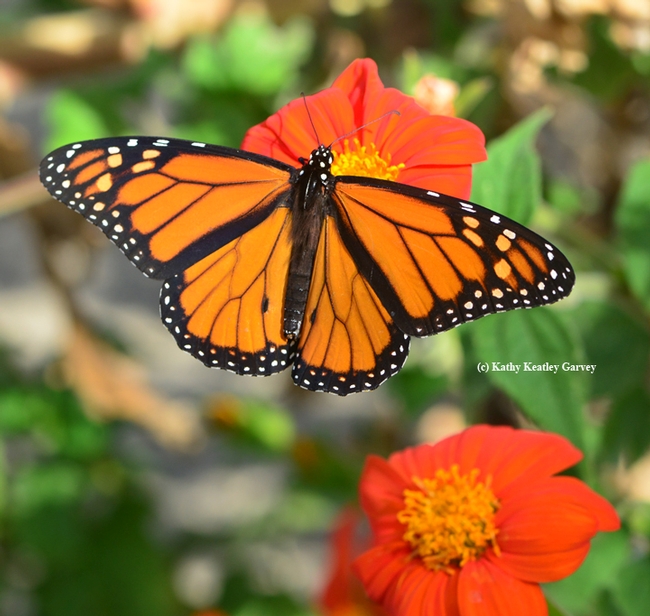Westward, ho!
The western migration of the Monarch butterflies (Danaus plexippus) to their overwintering sites along the California coast is underway.
Butterfly expert Art Shapiro, distinguished professor of evolution and ecology at the University of California, Davis, recorded four Monarchs at his Suisun monitoring site yesterday. He's been monitoring butterflies in Central California for some four decades.
This morning, a male Monarch fluttered into our yard to sip some nectar from a Mexican sunflower (Tithonia). (A distinguishing feature of the male Monarch: a small black spot on each of its two hindwings. See photo below.)
Monarchs head for sites along the coast, including Santa Cruz, Monterey, Natural Bridges and Pacific Grove, to overwinter, Shapiro noted.
"There used to be a small site in Fairfield, near the old Juvenile Hall on West Texas Street, in a row of Eucalyptus. It's been gone for decades. Some years they try to overwinter in Marin and Sonoma counties, but usually give up and shift south in December. In the past few years there has been a little winter breeding on the south coast. This was never recorded before."
The migration of the Monarchs to overwintering sites in central Mexico is well-publicized, but some monarchs head for the California coast. According to the monarchwatch.org website, monarchs east of the continental divide generally migrate to central Mexico from as far away as Ontario, Canada. "Monarchs west of the divide fly to the coast of California to spend the winter. They cluster together on tree limbs during the winter months in California by the thousands, and in central Mexico by the millions." (Download the PDF on the monarchwatch.org site.)
We're glad to see the huge national campaign to plant milkweed, the host plant of the Monarchs. The Xerces Society for Invertebrate Conservation has posted a wealth of information on its website for us to take action. The Monarch population has declined by more than 90 percent in under 20 years.
“Monarch butterflies are declining due to loss of habitat,” said Monarch Watch director Chip Taylor. “To assure a future for monarchs, conservation and restoration of milkweeds needs to become a national priority.”
It also helps to provide nectar resources for the Monarchs to help them along in their migration. In our yard, they like the Mexican sunflower (Tithonia), the butterfly bush (Buddleia davidii), and blue beard (Caryopteris × clandonensis). See list of Monarchs' favorite plants on the monarchwatch.org site.
Meanwhile, an occasional Monarch flutters into our family bee/butterfly garden to sip some nectar. Sometimes territorial native bees chase them away but the Monarchs return, determined to grab some flight fuel.
Westward, ho!
Attached Images:


